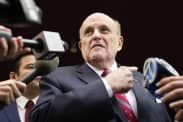The first week of what has traditionally been the worst month of the year for U.S. stocks got under way on Tuesday, with more poor economic data from China and further crude oil supply cuts by Saudi Arabia and Russia.
In China, the world’s second-largest economy, the services sector expanded at its slowest pace in eight months during August, adding to concerns about a global economic slowdown. In addition, an extension of production cuts by Saudi Arabia and Russia resulted in the Brent crude futures contract for November settling above $90 a barrel, reigniting fears that higher oil prices will keep inflation from slowing further.
Read: A stormy September for U.S. stocks may lie ahead. What investors need to know about Wall Street’s worst month.
September tends to be a disappointing period for the S&P 500 index
SPX,
which has delivered an average monthly return of minus 0.73% since 1945, according to CFRA Research. While some investors are holding out hope that this month may not be so bad given the U.S. economy’s ongoing strength and the S&P 500’s year-to-date gain of 17.1%, others point to the risk of a worrisome combination of easing U.S. growth plus inflation that rears up again.
“We are worried that, in the near term, we could get a pickup in inflation as the economy slows,” said Michael Reynolds, vice president of investment strategy at Glenmede, which oversees $42.5 billion in assets from Philadelphia. “The market is not prepared for this,” he said, citing the Cleveland Fed’s Inflation Nowcasting forecast for an almost 0.8% month-over-month increase in the August consumer price index, up from 0.2% in July and June.
On Tuesday, markets began to pick up on what Reynolds regards as the risk of “stagflation-lite” to “some extent, but not fully yet.” All three major U.S. stock indexes
DJIA
SPX
COMP
closed lower after the downbeat international data and a report showing U.S. factory orders fell 2.1% for July.
Meanwhile, 2-
BX:TMUBMUSD02Y,
10-
BX:TMUBMUSD10Y
and 30-year Treasury yields
BX:TMUBMUSD30Y
finished at their highest levels in one or two weeks, while the ICE U.S. Dollar Index
DXY
jumped 0.5%, as fed funds futures traders priced in a slightly greater chance of a 25-basis-point rate hike by the Federal Reserve in November or December. A hike of that size would push the fed funds target range to between 5.5%-5.75%.
“The narrative has been that we are likely to get immaculate disinflation, without any hiccups,” Reynolds said via phone.
However, “the rise in energy prices should flow into consumer prices over time, which is not good news for markets and would require a bigger correction than what we’ve seen,” something on the order of 20% for the S&P 500 from this summer’s peak, he said.
“We are nowhere near estimates of what we would call fair value. I wouldn’t say we were calling for a reacceleration of inflation, but it will likely be hard to get back to 2% inflation and the question is whether the Fed is going to be satisfied with 3% inflation. We could see that the economy slows down simultaneously, and it’s certainly a risk that could be the catalyst for a recession later this year or early next.”
As of Tuesday, the S&P 500 was off 2% from its 2023 closing high of 4,588.96 reached on July 31. U.S. stock markets were closed on Monday for the Labor Day holiday.
It was only on Friday that a nearly perfect official U.S. jobs report for August had fed funds futures traders reducing the likelihood of further Fed rate hikes this year. Optimism about economic-growth prospects also has one of Wall Street’s biggest names, Goldman Sachs
GS,
“Obviously, recession risks across the board have been dropping and most economists believe we are in for more of a soft landing,” Jon Maier, chief investment officer of Global X ETFs in New York, said via phone on Tuesday. “We’re coming off weeks where broader markets have had a pretty good performance. And while typically September is not the greatest of months, there are signs it may not be that bad.”







